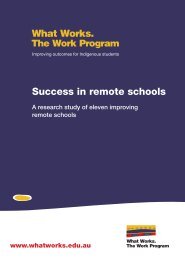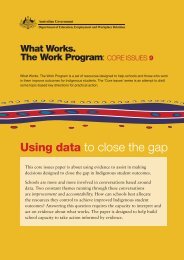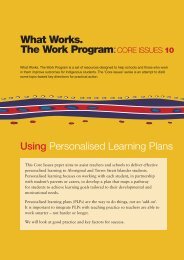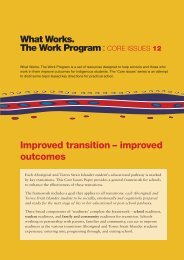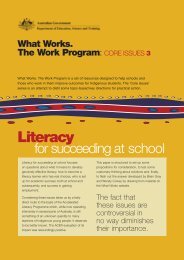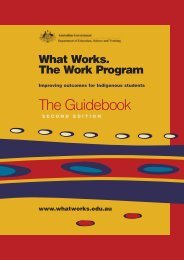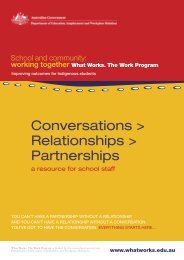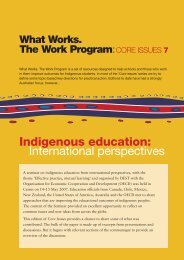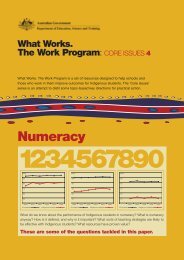Bound for Success Scope and Sequence Statements
Bound for Success Scope and Sequence Statements
Bound for Success Scope and Sequence Statements
- No tags were found...
Create successful ePaper yourself
Turn your PDF publications into a flip-book with our unique Google optimized e-Paper software.
SCIENCEEnergy <strong>and</strong> ChangeConcept In Year 1the student:In Year 2the student:In Year 3the student:In Year 4the student:In Year 5the student:In Year 6the student:In Year 7the student:In Year 8the student:In Year 9the student:Energy <strong>and</strong>changeEnergy is vital to ourexistence <strong>and</strong> to thequality or life asindividuals <strong>and</strong>society• Knows that energy issomething that we need inour daily lives (e.g. says“I need energy to runaround <strong>and</strong> throw a ball”<strong>and</strong> “I run out of energywhen I’m tired”).• Knows that we have manyuses of energy in our lives(e.g. says ”we use energyto keep warm or cold, helpus see at night <strong>and</strong> use theTV”).• Knows that leaving a lighton all night ‘wastes’energy <strong>and</strong> takes action toavoid this.• Knows that differentthings can ‘have’ energy(e.g. says “things thatmove such as cars, footyplayers, <strong>and</strong> wind-up toyshave energy”).• Knows that the sun is asource of energy because itmakes us warm <strong>and</strong> helpsplants to grow.• Knows the basic effect ofenergy is to enable thingsto work or happen (e.g.says “We need energy <strong>for</strong>plants to grow, <strong>for</strong> the sunto shine, <strong>for</strong> music toplay”).• Identifies when energy isbeing used (e.g. says“energy is being usedbecause I am breathing<strong>and</strong> walking, toys aremoving <strong>and</strong> fruit issmelling”).• Recognises that differenttypes of energy are needed<strong>for</strong> things to ‘work’ ineveryday lives (e.g. says“electricity is needed <strong>for</strong>the TV <strong>and</strong> washingmachine, petrol is needed<strong>for</strong> the car <strong>and</strong> food isneeded <strong>for</strong> us”).• Knows that heat <strong>and</strong> lightare types of energy <strong>and</strong>that when a heater or lightis turned off we ‘save’energy.• Knows that petrol,batteries, <strong>and</strong> food, as wellas oil, gas <strong>and</strong> c<strong>and</strong>le waxare types of energy.• Knows that sound is a typeof energy <strong>and</strong> there aredifferent sounds.• Lists the <strong>for</strong>ms of energypresent in their home <strong>and</strong>classroom (e.g. light, heat,sound, electricity) <strong>and</strong>gives examples ofappliances that use these<strong>for</strong>ms (e.g. a hairdryermoves air which makes asound <strong>and</strong> gives heat).• Knows that ‘fuels’ are a<strong>for</strong>m of energy (e.g.petrol, oil, gas, food) <strong>and</strong>can list how each of thesefuels are used at home <strong>and</strong>in the community.• Knows that the sun is themain sources of energy <strong>for</strong>life <strong>and</strong> can say how weuse the sun’s energy in ourdaily lives (e.g. says “weuse the sun’s energy tokeep us warm, to see, toheat water <strong>and</strong> <strong>for</strong> plantsto grow”).• Knows the dangers of thesuns rays <strong>and</strong> knows howto protect themselves fromover-exposure. HPE• Knows that householdfuels (petrol, gas <strong>and</strong> oil)are natural <strong>for</strong>ms ofenergy, knows theircommon source is oil <strong>and</strong>knows where oil comesfrom. Knows that coal isanother natural source ofenergy <strong>and</strong> can say whereit comes from, how it ismined <strong>and</strong> how it ischanged from coal toproduce electricity <strong>for</strong> ouruse.• Identifies different <strong>for</strong>ms<strong>and</strong> sources of energy usedin their communities <strong>and</strong>gives examples. Knowsthat the sun is the mainsource of energy <strong>for</strong> life<strong>and</strong> that from it we getheat, light <strong>and</strong> solarenergy, <strong>and</strong> can say howwe use this energy.• Knows that food is asource of energy <strong>and</strong>recognises that some foods(e.g. fatty foods) containmore energy than others.HPE• Knows that water <strong>and</strong>wind are energy sources<strong>and</strong> can say how they areused in their localcommunity.• Knows different sources<strong>and</strong> <strong>for</strong>ms of energy <strong>and</strong>the different uses each ofthese may have.• Knows that water <strong>and</strong>wind are energy sources(e.g. water wheels, tidalenergy, windmills <strong>and</strong>wind turbines) <strong>and</strong> givesexamples of how <strong>and</strong>where these are utilised.• Compares the differenttypes of energy in terms ofthe variety of uses eachmight have.• Knows different patternsof energy use, in terms ofseasons <strong>and</strong> times of day,<strong>and</strong> underst<strong>and</strong>s why it isimportant to conserveenergy including thedifferent ways this can bedone in communities <strong>and</strong>homes.• Classifies energy types interms of whether they arerenewable (sun, wind,water) or non-renewable(fossil fuels) <strong>and</strong>underst<strong>and</strong>s theimplications of this <strong>for</strong> ourcommunities.• Knows that some <strong>for</strong>ms ofenergy are better <strong>for</strong> ourenvironment that others(e.g. says “adding ethanolto petrol can help reducecarbon emissions”)• Describes ways in whichdifferent <strong>for</strong>ms of energycan be stored. Knows thatenergy is stored in food<strong>and</strong> classifies foods as highin energy or low in energy,<strong>and</strong> knows that foods highin energy are more likelyto result in weight gain.• Knows that energy isstored in batteries <strong>and</strong> thatdifferent batteries lastlonger than others becausethey store more energy.Knows that petrol, oil <strong>and</strong>gas are examples of storedenergy <strong>and</strong> can generalisethat all fuels (includingfood <strong>and</strong> c<strong>and</strong>le wax) aretypes of stored energy.Knows that stored energydoes not result in workbeing done until it is used(e.g. says “we don’t haveenergy to move until thefood is eaten” <strong>and</strong> “untilthe battery is in the torch<strong>and</strong> it’s switched on wedon’t have the energy tomake the light”).• Compares the use ofrenewable <strong>and</strong> nonrenewableenergy sources).• Investigates alternativesources of energy <strong>and</strong>knows why it is importantthat these be developed<strong>and</strong> used.• Knows the nature ofenergy <strong>and</strong> is familiar withdifferent <strong>for</strong>ms <strong>and</strong> thenature of each typeincluding heat, electricity,sound, light, stored(chemical), movement(mechanical), tidal, wave,nuclear.• Knows that when an objectis poised ready to move ithas potential energy(energy of position) (e.g. acoiled spring <strong>and</strong> personon a bike at the top of ahill poised ready to comedown have potentialenergy).• Knows that when an objectis moving (e.g. personrunning, plane flying, ballmoving) it has kineticenergy.• Knows the features ofrenewable energy sourcessuch as wind, solar <strong>and</strong>wave, <strong>and</strong> of nonrenewable sources such asnatural gas, coal, <strong>and</strong>petrol.• Knows how energy can beconserved in the home <strong>and</strong>community <strong>and</strong> practicesenergy efficiency in theclassroom, school <strong>and</strong> athome.• Considers <strong>and</strong> comparesexamples of energysources (including wind,solar, wave, coal, gas) interms of use, cost, abilityto be renewed <strong>and</strong> theireffects on the environment.• Knows that the sun is thesource of fossil fuels (coal,gas, oil) <strong>and</strong> what it meansin terms of human activity<strong>and</strong> the total energy cycle.• Knows that all energy canbe classified as potential(when things are stored,under pressure or ready tomove) or kinetic (when anobject is moving) <strong>and</strong>gives examples.• Knows that potentialenergy can be harnessed<strong>for</strong> useful purposes (e.g.water in a dam).• Knows how the choice ofbuilding materials <strong>and</strong>design when building anew home can result inenergy wastage <strong>and</strong> howenergy can be conservedthrough wise choices <strong>and</strong>good design.Energy can betransferred from one<strong>for</strong>m to another <strong>and</strong>change involves thetransfer of energy• Knows that things move indifferent ways (e.g. “thatcar is moving slowly “ <strong>and</strong>“the ball is moving up <strong>and</strong>down <strong>and</strong> spinning”).• Knows that we can push<strong>and</strong> pull things <strong>and</strong> knowsthe difference (e.g. says “Ipush the door open” <strong>and</strong>“I pull the dog on theleash”).• Knows that sometimesenergy makes things move(e.g. says “the wind ismaking that flag move, <strong>and</strong>“when we move our legson the pedals the bikemoves”).• Recognises that pushing orpulling objects can makethem move (e.g. says“when I push the chair itmoves” <strong>and</strong> “when I pullthe lid off it moves”).• Can compare themovement of differentobjects (e.g. says “the redball is going faster thanthe blue one”).• Knows that pushing <strong>and</strong>pulling something indifferent ways affects itsmotion <strong>and</strong> shape <strong>and</strong> thatenergy causes that change(e.g. uses a knife to cut apizza <strong>and</strong> knows thatpushing or pulling it<strong>for</strong>wards, backwards,sideways results indifferent effects), ie.knows that <strong>for</strong>ces (pushes<strong>and</strong> pulls) can be big orsmall <strong>and</strong> so can theeffects (e.g. says “when Ipush the toy car hard itgoes faster <strong>and</strong> <strong>for</strong> longerthan when I push it softly”,<strong>and</strong> “I need to push hardon my bike pedals whenI’m going up hill”).• Knows how pushing <strong>and</strong>pulling can make thingsmove in a variety ofdirections.• Knows the effects ofpushing <strong>and</strong> pulling inswings in the playgroundin different ways <strong>and</strong> c<strong>and</strong>escribe these using wordslike ‘twists, turns, spins’.• Explores the effects ofpushing <strong>and</strong> pulling onplasticine or poster putty<strong>and</strong> demonstrates theresulting different shapes.• Predicts then investigatesthe effects of different<strong>for</strong>ces (pushes <strong>and</strong> pulls)(e.g. says “If I squeeze thetoothpaste it will come outthe top” <strong>and</strong> “if the windblows that way the flagwill fly that way”).• Recognises that energymoves from one thing toanother (e.g. says“electricity moves througha cord from the powersocket into the fan <strong>and</strong> thiscauses the blades to move”<strong>and</strong> “gas from the hotplateheats the frying pan whichheats the sausages so theycook” <strong>and</strong> “a personkicking a football causesthe ball to move”).• Compares the effects thatdifferent sized <strong>for</strong>ces haveon the shape <strong>and</strong> motion ofobjects. Knows thatpushing <strong>and</strong> pulling cancause things to changeshape or even break.Knows that when a push orpull occurs energy movesfrom one object to another(e.g. when a toy car ispushed energy moves fromthe person to the car <strong>and</strong>when they push on theirpedals energy moves fromthem to the pedals).• Knows that when energymoves from one thing toanother it changes <strong>for</strong>ms(e.g. when electricitymoves through a cord intothe washing machine theelectrical energy changesinto movement (ormechanical) energy insidethe machine; whenelectricity goes into an ironthe electrical energychanges into heat energy;when sound energy goesinto a telephone it changesinto electricity <strong>and</strong> backinto sound energy at theother end).• Knows that <strong>for</strong>ces causemotion <strong>and</strong> that some<strong>for</strong>ces can act at a distancefrom an object (e.g.magnetism, gravity)without touching it (a noncontact<strong>for</strong>ce) while others(e.g. pushes <strong>and</strong> pulls) canonly act when in contactwith another objects(contact <strong>for</strong>ces).• Describes ways in whichdifferent <strong>for</strong>ms of energycan be transferred. Knowsthat objects can beclassified as either sourcesof receivers of energy(e.g. says “the sun is asource of energy <strong>and</strong>plants are receivers” <strong>and</strong>“a battery is a source <strong>and</strong>a torch is a receiver”).Knows that differentenergy converters changeone <strong>for</strong>m of energy intoanother (e.g. says “an ironconverts electricity intoheat <strong>and</strong> a person convertsfood into movement orsound <strong>and</strong> a car convertsfuel into movement”).Knows that electricalenergy can be transferredinto other <strong>for</strong>ms through abasic circuit (e.g. says“stored energy in a batterycan be converted intoelectrical energy <strong>and</strong> theninto light energy in a globeor sound energy in abell”).• Knows that energytransfers are involved inthe operation of everydayequipment or machines(e.g. MP3 player,hairdryer, CD player,fridge) <strong>and</strong> shows these assimple flow diagrams.• Investigate simple energytransfers <strong>and</strong> depicts themas flow diagrams or energychains, emphasizing theimportance of the sun asthe primary source of mostenergy (e.g. sunswamp oil reserveservice station petrol;sun sheep meathuman exercise; sunclouds rainfalldamshydroelectricitysound (radio)).• Knows how energy isconverted from one <strong>for</strong>mto another <strong>and</strong> representthis in simple flowdiagrams (e.g. electricheater: electrical energy heat energy; light globe:electrical energy heat• Considers <strong>and</strong> describeshow <strong>and</strong> why energymoves through differentmedia; knows theimportance of heat energyto life on the planet <strong>and</strong>how it can be transferred,by conduction (using thekinetic model), convection<strong>and</strong> radiation; knows howcolour <strong>and</strong> texture ofsurfaces effects heattransfer. Knows how theprinciples of heat transferapply to vacuum flasks,insulation in houses <strong>and</strong>solar hot water systems.• Knows the importance ofexpansion with heat <strong>and</strong>ways it is used in daily life(e.g. thermostats, bimetalfire alarms, thermometers,car cylinders).• Knows that atoms haveelectric charge (thatprotons have a positivecharge <strong>and</strong> electrons havea negative charge), thattransfer of electronsproduces like <strong>and</strong> unlike<strong>Bound</strong> <strong>for</strong> <strong>Success</strong> <strong>Scope</strong> <strong>and</strong> <strong>Sequence</strong> <strong>Statements</strong> V2 Page 53 Working Document Semester One 2007



